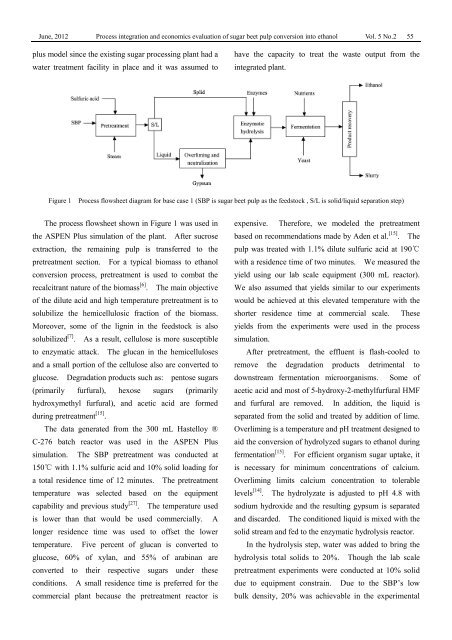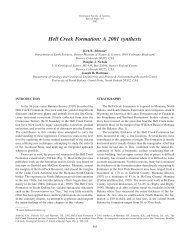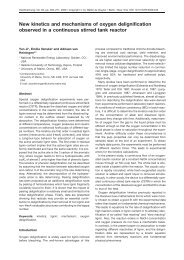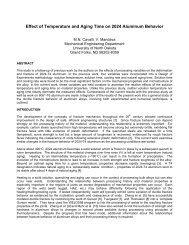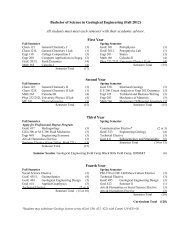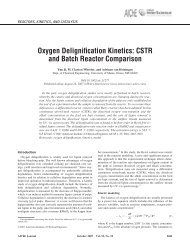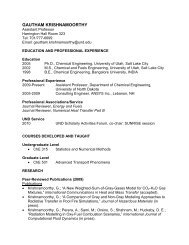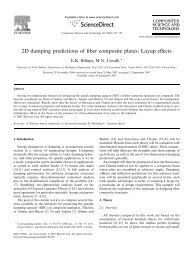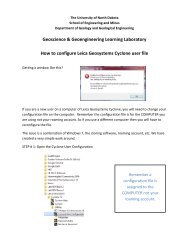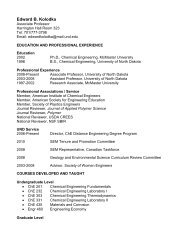Process integration and economics evaluation of sugar beet pulp ...
Process integration and economics evaluation of sugar beet pulp ...
Process integration and economics evaluation of sugar beet pulp ...
Create successful ePaper yourself
Turn your PDF publications into a flip-book with our unique Google optimized e-Paper software.
June, 2012 <strong>Process</strong> <strong>integration</strong> <strong>and</strong> <strong>economics</strong> <strong>evaluation</strong> <strong>of</strong> <strong>sugar</strong> <strong>beet</strong> <strong>pulp</strong> conversion into ethanol Vol. 5 No.2 55<br />
plus model since the existing <strong>sugar</strong> processing plant had a<br />
water treatment facility in place <strong>and</strong> it was assumed to<br />
have the capacity to treat the waste output from the<br />
integrated plant.<br />
Figure 1<br />
<strong>Process</strong> flowsheet diagram for base case 1 (SBP is <strong>sugar</strong> <strong>beet</strong> <strong>pulp</strong> as the feedstock , S/L is solid/liquid separation step)<br />
The process flowsheet shown in Figure 1 was used in<br />
the ASPEN Plus simulation <strong>of</strong> the plant. After sucrose<br />
extraction, the remaining <strong>pulp</strong> is transferred to the<br />
pretreatment section. For a typical biomass to ethanol<br />
conversion process, pretreatment is used to combat the<br />
recalcitrant nature <strong>of</strong> the biomass [6] . The main objective<br />
<strong>of</strong> the dilute acid <strong>and</strong> high temperature pretreatment is to<br />
solubilize the hemicellulosic fraction <strong>of</strong> the biomass.<br />
Moreover, some <strong>of</strong> the lignin in the feedstock is also<br />
solubilized [7] . As a result, cellulose is more susceptible<br />
to enzymatic attack. The glucan in the hemicelluloses<br />
<strong>and</strong> a small portion <strong>of</strong> the cellulose also are converted to<br />
glucose. Degradation products such as: pentose <strong>sugar</strong>s<br />
(primarily furfural), hexose <strong>sugar</strong>s (primarily<br />
hydroxymethyl furfural), <strong>and</strong> acetic acid are formed<br />
during pretreatment [15] .<br />
The data generated from the 300 mL Hastelloy ®<br />
C-276 batch reactor was used in the ASPEN Plus<br />
simulation. The SBP pretreatment was conducted at<br />
150℃ with 1.1% sulfuric acid <strong>and</strong> 10% solid loading for<br />
a total residence time <strong>of</strong> 12 minutes. The pretreatment<br />
temperature was selected based on the equipment<br />
capability <strong>and</strong> previous study [27] . The temperature used<br />
is lower than that would be used commercially. A<br />
longer residence time was used to <strong>of</strong>fset the lower<br />
temperature. Five percent <strong>of</strong> glucan is converted to<br />
glucose, 60% <strong>of</strong> xylan, <strong>and</strong> 55% <strong>of</strong> arabinan are<br />
converted to their respective <strong>sugar</strong>s under these<br />
conditions. A small residence time is preferred for the<br />
commercial plant because the pretreatment reactor is<br />
expensive.<br />
Therefore, we modeled the pretreatment<br />
based on recommendations made by Aden et al. [15] .<br />
The<br />
<strong>pulp</strong> was treated with 1.1% dilute sulfuric acid at 190℃<br />
with a residence time <strong>of</strong> two minutes.<br />
We measured the<br />
yield using our lab scale equipment (300 mL reactor).<br />
We also assumed that yields similar to our experiments<br />
would be achieved at this elevated temperature with the<br />
shorter residence time at commercial scale.<br />
These<br />
yields from the experiments were used in the process<br />
simulation.<br />
After pretreatment, the effluent is flash-cooled to<br />
remove the degradation products detrimental to<br />
downstream fermentation microorganisms.<br />
Some <strong>of</strong><br />
acetic acid <strong>and</strong> most <strong>of</strong> 5-hydroxy-2-methylfurfural HMF<br />
<strong>and</strong> furfural are removed.<br />
In addition, the liquid is<br />
separated from the solid <strong>and</strong> treated by addition <strong>of</strong> lime.<br />
Overliming is a temperature <strong>and</strong> pH treatment designed to<br />
aid the conversion <strong>of</strong> hydrolyzed <strong>sugar</strong>s to ethanol during<br />
fermentation [15] .<br />
For efficient organism <strong>sugar</strong> uptake, it<br />
is necessary for minimum concentrations <strong>of</strong> calcium.<br />
Overliming limits calcium concentration to tolerable<br />
levels [14] .<br />
The hydrolyzate is adjusted to pH 4.8 with<br />
sodium hydroxide <strong>and</strong> the resulting gypsum is separated<br />
<strong>and</strong> discarded.<br />
The conditioned liquid is mixed with the<br />
solid stream <strong>and</strong> fed to the enzymatic hydrolysis reactor.<br />
In the hydrolysis step, water was added to bring the<br />
hydrolysis total solids to 20%. Though the lab scale<br />
pretreatment experiments were conducted at 10% solid<br />
due to equipment constrain. Due to the SBP’s low<br />
bulk density, 20% was achievable in the experimental


